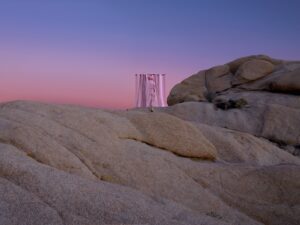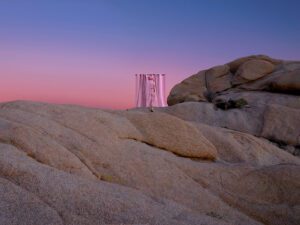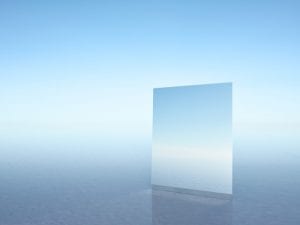Kati Thanda-Lake Eyre Basin spans 1.2 million square kilometers, covering almost one-sixth of Australia. At its heart is one of the country’s largest salt lakes. It looks like an endless sheet of still water that mirrors the sky in all directions. On 3 January 2013, the site officially received its dual name in recognition of its significance to the Arabana people of Southern Australia. Photographer Murray Fredericks (b. 1970) first visited the region in 2003. He has returned over 31 times in the past two decades to create and capture various interventions that expand, disrupt and reflect the landscape. For instance, the Vanity series features enormous rectangular mirrors whilst his most recent work, Blaze, shows lone flames surrounded by sky. Doing so challenges the traditions of simply serene landscape art. Now, the Museum of Australian Photography surveys his intriguing body of work in its current exhibition: The salt lake.

Fredericks highlights the boundless space and abstract qualities of this setting. For example, Array #1 shows a profusion of stars that fill every inch of the frame. They are made even more beautiful by the artist’s attention to the subtle hues behind them. Here, the night sky is not purely black but a soft gradient that begins at the horizon line, transitioning from the palest orange to white and blue. Fredericks assembles five standing mirrors in the centre of the composition, which reflect the details viewers wouldn’t usually be able to see. This invites us to appreciate the true scale of such an endless expanse. Each mirror is covered in a unique display of constellations and clouds – its own piece of the infinite. The image-maker inspires use to think about art, space and our own place in an incomprehensibly vast universe.

The site remains a constant as Fredericks’ ideas evolve over time. Projects typically involve him camping alone for weeks to completely immersive himself in the setting. “When I first visited the lakebed, my initial impressions were those of standing within a monotonous, seemingly infinite wasteland. The mind struggled to familiarise itself with the environment as there were no obvious ‘features’ or ‘points of interest’ to break up the surface” he explains. The lens-based artist continues: “The experience of being out there in the centre for long periods has a very profound effect on your mental state. It’s that effect, the quality of the emotional and metaphysical experience that I hope these images convey.” For Fredericks, the physical, mental and spiritual journey goes into images that preserve a fraction of what it’s like to be there.

The photographer strives to achieve the impossible: to capture the infinite. His images invite viewers to experience the transportive potential of light, colour and space. The elements he adds to the scene call to mind the works of Margeaux Walter and Shirin Abedinirad. Fredericks’ work takes us to a space of emptiness that is a departure from the constant visual distractions of modern life. We are prompted to see differently, attuning our senses to what makes a space interesting when the usual stimuli are stripped away. There’s a subtle beauty to the elements beyond human control, from the clouds that shift above us to the ripples in the water below. Fredericks reflects: “Standing in the silken water, surrounded only by a boundless horizon, I sense a release, a surrendering as the self dissolves into the light and space.”
Museum of Australian Photography, Murray Fredericks: The salt lake | Until 18 February
Words: Diana Bestwish Tetteh
Image Credits:
- Murray FREDERICKS BLAZE 27 2023 pigment print on cotton rag 120.0 x 150.0 cm Courtesy of the artist and ARC ONE Gallery (Melbourne).
- Murray FREDERICKS West Portal 2000 Digital pigment print Courtesy of the artist and ARC ONE Gallery (Melbourne).
- Murray FREDERICKS BLAZE 28 2023 pigment print on cotton rag 120.0 x 150.0 cm Courtesy of the artist and ARC ONE Gallery (Melbourne).
- Murray FREDERICKS Arthurs Plains Smoke 2001 Digital pigment print Courtesy of the artist and ARC ONE Gallery (Melbourne).





